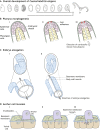The extracellular matrix in development
- PMID: 32467294
- PMCID: PMC7272360
- DOI: 10.1242/dev.175596
The extracellular matrix in development
Abstract
As the crucial non-cellular component of tissues, the extracellular matrix (ECM) provides both physical support and signaling regulation to cells. Some ECM molecules provide a fibrillar environment around cells, while others provide a sheet-like basement membrane scaffold beneath epithelial cells. In this Review, we focus on recent studies investigating the mechanical, biophysical and signaling cues provided to developing tissues by different types of ECM in a variety of developing organisms. In addition, we discuss how the ECM helps to regulate tissue morphology during embryonic development by governing key elements of cell shape, adhesion, migration and differentiation.
Keywords: Adhesion; Biophysical; Differentiation; Embryo; Extracellular matrix; Migration.
© 2020. Published by The Company of Biologists Ltd.
Conflict of interest statement
Competing interestsThe authors declare no competing or financial interests.
Figures




References
-
- Abagnale G., Steger M., Nguyen V. H., Hersch N., Sechi A., Joussen S., Denecke B., Merkel R., Hoffmann B., Dreser A. et al. (2015). Surface topography enhances differentiation of mesenchymal stem cells towards osteogenic and adipogenic lineages. Biomaterials 61, 316-326. 10.1016/j.biomaterials.2015.05.030 - DOI - PubMed
-
- Accogli A., Calabretta S., St-Onge J., Boudrahem-Addour N., Dionne-Laporte A., Joset P., Azzarello-Burri S., Rauch A., Krier J., Fieg E. et al. (2019). De Novo pathogenic variants in N-cadherin cause a syndromic neurodevelopmental disorder with corpus collosum, axon, cardiac, ocular, and genital defects. Am. J. Hum. Genet. 105, 854-868. 10.1016/j.ajhg.2019.09.005 - DOI - PMC - PubMed
-
- Afasizheva A., Devine A., Tillman H., Fung K. L., Vieira W. D., Blehm B. H., Kotobuki Y., Busby B., Chen E. I. and Tanner K. (2016). Mitogen-activated protein kinase signaling causes malignant melanoma cells to differentially alter extracellular matrix biosynthesis to promote cell survival. BMC Cancer 16, 186 10.1186/s12885-016-2211-7 - DOI - PMC - PubMed
-
- Alberts B., Johnson A., Lewis J., Morgan D., Raff M., Roberts K. and Walter P. (2014). Molecular Biology of the Cell. New York, NY: Garland Science.
Publication types
MeSH terms
LinkOut - more resources
Full Text Sources
Research Materials

